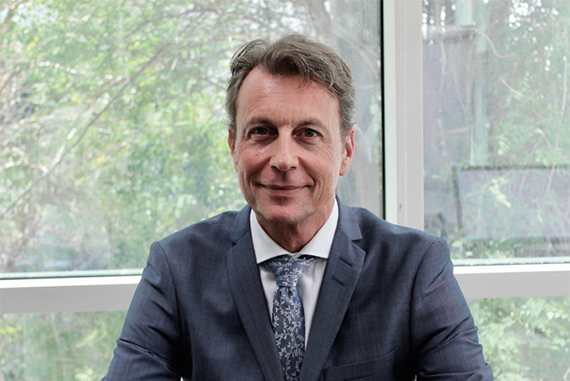More news
- Ask Joe Powder – October 2024
- Chinese paint majors look to domestic consumer sales as commercial real estate slumps
- Architectural coatings in Nepal and Bhutan
- A wild ride for U.S. construction and housing: Coatings and adhesives opportunities in 202...
- Levant paint industry and market marred by armed conflict and civil turmoil

In the second of our interviews with leading members of the coatings community who are exhibiting at the Middle East Coatings Show, PPCJ spoke to Dr Hendrik Schoenfelder, Regional President, Middle East & Africa at Evonik, to discover the challenges and trends facing the industry and how they plan to return to ‘business as usual’
Why is the Middle East an important region to Evonik?
Evonik’s interest in the Middle East is twofold. On the one hand, there is a decent market of 450M inhabitants creating a combined gross domestic product of more than 4% of the global total – growing faster than in most other regions. That combination renders the end-user market attractive for our B2B-customers to allocate more production capacity to the region. On the other hand, the Middle East and Africa offers fantastic opportunities to source chemical raw materials and energy. And that holds for both the traditional oil & gas based supply, as well as the newly developing area of sustainably generated electricity and chemicals with a low carbon footprint.
What products or technology have you got on display at the Middle East Coatings Show?
Evonik is showcasing a broad line of crosslinkers and curing agents for use in high solids, waterborne and other environmentally-friendly epoxy coatings systems. Recent amine curing agent technology allows for the design of ultra-low emission epoxy paints that meet VOC and environmental regulations without compromising on handling or performance. Furthermore, Evonik is highlighting Anquamine® waterborne curing agents for civil engineering, which are easy to use and cost effective, with the same or superior performance vs traditional solvent epoxy-based systems. The latest is VESTANAT® EP-E 95, a high solid, ethoxy-silane-based crosslinker for ultra-high performance in 1K coatings enabling scratch resistance, stain resistance and anti-graffiti effect.
For its coating additives line, Evonik is exhibiting novel solutions for water and solventborne coatings applications, as well as its recently launched Architectural Coatings Foamex range 2,5,6 and 9 that display great compatibility and defoaming efficiency.
We are also introducing Evonik’s unique e-learning services that offer information about coating technologies and additives for beginners and experts.
What industry trends are currently influencing Evonik?
The predominant trend that Evonik is focusing on is, without doubt, sustainability and hence, the focus remains on offering our value proposition with our products especially in the coatings industry.
Quintessentially, we offer solutions to meet challenging environmental regulations, thus contributing to the following: a) durability by protecting surfaces and extending shelf life; b) less maintenance by reducing repair work and ensuring long-term cost savings; c) more protection to structures and food; d) less carbon dioxide emission by reducing energy consumption, hence helping create clean energy.
To summarise, Evonik is geared towards providing sustainable solutions and achieving the United Nations Sustainable Development Goals; more than 80% of its sales has already positively contributed towards these goals.
How has COVID-19 impacted operations at Evonik? When do you expect it to be ‘business as usual’?
Evonik’s business contracted in 2020 versus the prior year by about 7% in terms of sales revenue. That decline, though far from the painful collapses of other industries, obviously came with severe restrictions. In manufacturing, we had to maintain social distancing protocol in a highly physical work environment and we are proud that we kept our plants functioning with very limited interruptions. The virtual operation of the customer interface was surprisingly effective for day-to-day tasks. The recovery at the beginning of this year was so steep that it stretched our supply chain beyond the limits. Many customers felt shortages as we had to postpone or limit orders. So, "business as usual” may not be the right term to describe this overshooting demand surge, but yes, it seems the worst of the pandemic is behind us.
Aside from COVID, what are the most pressing challenges in the industry at the moment and how do you address them?
The primary challenge that the coatings industry faces is business sustainability. The COVID-19 outbreak had significantly impacted the market by restricting trade and disrupting the supply chain, causing an inflationary trend in 2021 which further cascades as a domino effect in the value chain. Although these challenges persist, Evonik as a responsible partner continues to service its customers by ensuring the supply of speciality chemicals, albeit the delivery delays and other restrictions.
How important do you think doing business ‘in person’ will be in aiding post COVID-19 recovery for businesses in the chemicals industry?
Overall, we were surprised with the good effectiveness of most of the virtual formats of co-operation during the pandemic – internal and external. However, intense interaction between the technical teams of the customers and us is a key driver for innovation – and that was very challenging to pursue last year. Without the direct touch and feel, without the quick, joint and interactive analysis of samples, prototypes and ideas, it is very hard to develop new products that are in the physical space – and that is what most of our customers do. From that perspective, 2020 was a year of slower progress in many areas. We are more than happy that our customers have now started to invite us to visit their labs and workshops, to create new products and formulations together. And, these joint activities pave the way for the growth of the future.



